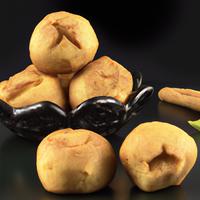
1 serving (50 grams) contains 220 calories, 2.5 grams of protein, 10.0 grams of fat, and 30.0 grams of carbohydrates.

Log this food in SnapCalorie

Nutrition Information
Calories |
1043.4 | ||
|---|---|---|---|
% Daily Value* |
|||
| Total Fat | 47.3 g | 60% | |
| Saturated Fat | 23.7 g | 118% | |
| Polyunsaturated Fat | 0 g | ||
| Cholesterol | 23.7 mg | 7% | |
| Sodium | 354.9 mg | 15% | |
| Total Carbohydrates | 142.0 g | 51% | |
| Dietary Fiber | 2.4 g | 8% | |
| Sugars | 71.0 g | ||
| protein | 11.8 g | 23% | |
| Vitamin D | 0 mcg | 0% | |
| Calcium | 118.3 mg | 9% | |
| Iron | 3.5 mg | 19% | |
| Potassium | 236.6 mg | 5% | |
* Percent Daily Values are based on a 2,000 calorie diet. Your daily values may be higher or lower depending on your calorie needs.
Food Attributes
Source of Calories
About Balushai
Balushai is a popular dessert originating from Indian cuisine, often enjoyed during festivals and celebrations. Made from a dough of refined flour (maida), clarified butter (ghee), and yogurt, it takes the form of flaky, deep-fried pastries with a golden crust. These are then dipped in thick sugar syrup, creating a rich sweetness. While Balushai offers a delightful combination of textures and flavors, its nutritional profile leans toward indulgence rather than health. It is calorie-dense owing to its sugar content and frying process, and it contains high amounts of fats from the ghee. On the upside, its use of yogurt adds a slight probiotic element, though this is minimal in comparison to the dessert's overall richness. Balushai is best enjoyed as an occasional treat, in moderation, as part of a balanced diet.



